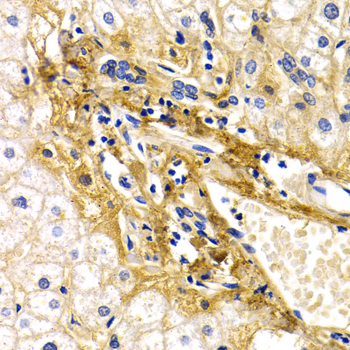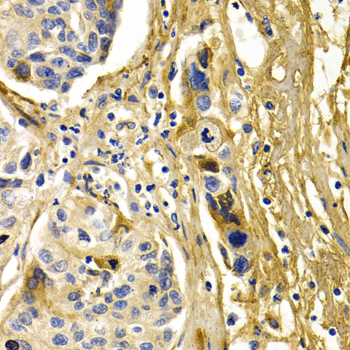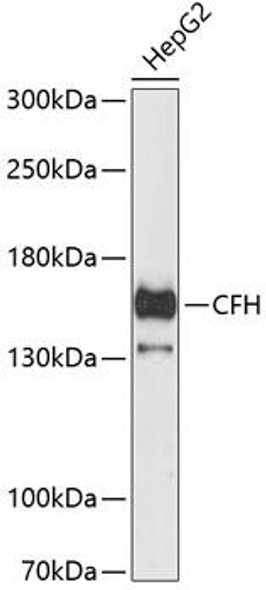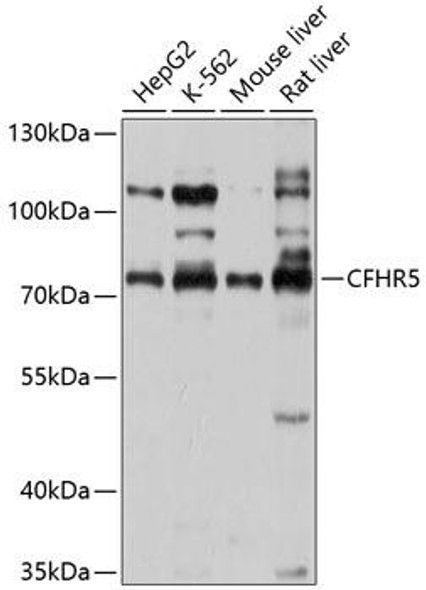Immunology Antibodies 2
Anti-CFH Antibody (CAB2166)
- SKU:
- CAB2166
- Product Type:
- Antibody
- Reactivity:
- Human
- Host Species:
- Rabbit
- Isotype:
- IgG
- Research Area:
- Immunology
Description
| Antibody Name: | Anti-CFH Antibody |
| Antibody SKU: | CAB2166 |
| Antibody Size: | 20uL, 50uL, 100uL |
| Application: | IHC |
| Reactivity: | Human |
| Host Species: | Rabbit |
| Immunogen: | Recombinant fusion protein containing a sequence corresponding to amino acids 20-270 of human CFH (NP_001014975.1). |
| Application: | IHC |
| Recommended Dilution: | IHC 1:50 - 1:200 |
| Reactivity: | Human |
| Positive Samples: |
| Immunogen: | Recombinant fusion protein containing a sequence corresponding to amino acids 20-270 of human CFH (NP_001014975.1). |
| Purification Method: | Affinity purification |
| Storage Buffer: | Store at -20'C. Avoid freeze / thaw cycles. Buffer: PBS with 0.02% sodium azide, 50% glycerol, pH7.3. |
| Isotype: | IgG |
| Sequence: | DCNE LPPR RNTE ILTG SWSD QTYP EGTQ AIYK CRPG YRSL GNVI MVCR KGEW VALN PLRK CQKR PCGH PGDT PFGT FTLT GGNV FEYG VKAV YTCN EGYQ LLGE INYR ECDT DGWT NDIP ICEV VKCL PVTA PENG KIVS SAME PDRE YHFG QAVR FVCN SGYK IEGD EEMH CSDD GFWS KEKP KCVE ISCK SPDV INGS PISQ KIIY KENE RFQY KCNM GYEY SERG DAVC TESG WRPL PSCE EKSC DNP |
| Gene ID: | 3075 |
| Uniprot: | P08603 |
| Cellular Location: | Secreted |
| Calculated MW: | 51kDa/139kDa |
| Observed MW: |
| Synonyms: | CFH, AHUS1, AMBP1, ARMD4, ARMS1, CFHL3, FH, FHL1, HF, HF1, HF2, HUS |
| Background: | This gene is a member of the Regulator of Complement Activation (RCA) gene cluster and encodes a protein with twenty short consensus repeat (SCR) domains. This protein is secreted into the bloodstream and has an essential role in the regulation of complement activation, restricting this innate defense mechanism to microbial infections. Mutations in this gene have been associated with hemolytic-uremic syndrome (HUS) and chronic hypocomplementemic nephropathy. Alternate transcriptional splice variants, encoding different isoforms, have been characterized. |
| UniProt Protein Function: | CFH: Factor H functions as a cofactor in the inactivation of C3b by factor I and also increases the rate of dissociation of the C3bBb complex (C3 convertase) and the (C3b)NBB complex (C5 convertase) in the alternative complement pathway. Genetic variations in CFH are associated with basal laminar drusen (BLD); also known as drusen of Bruch membrane or cuticular drusen or grouped early adult-onset drusen. Drusen are extracellular deposits that accumulate below the retinal pigment epithelium on Bruch membrane. Basal laminar drusen refers to an early adult-onset drusen phenotype that shows a pattern of uniform small, slightly raised yellow subretinal nodules randomly scattered in the macula. In later stages, these drusen often become more numerous, with clustered groups of drusen scattered throughout the retina. In time these small basal laminar drusen may expand and ultimately lead to a serous pigment epithelial detachment of the macula that may result in vision loss. Defects in CFH are the cause of complement factor H deficiency (CFHD). A disorder that can manifest as several different phenotypes, including asymptomatic, recurrent bacterial infections, and renal failure. Laboratory features usually include decreased serum levels of factor H, complement component C3, and a decrease in other terminal complement components, indicating activation of the alternative complement pathway. It is associated with a number of renal diseases with variable clinical presentation and progression, including membranoproliferative glomerulonephritis and atypical hemolytic uremic syndrome. Defects in CFH are a cause of susceptibility to hemolytic uremic syndrome atypical type 1 (AHUS1). An atypical form of hemolytic uremic syndrome. It is a complex genetic disease characterized by microangiopathic hemolytic anemia, thrombocytopenia, renal failure and absence of episodes of enterocolitis and diarrhea. In contrast to typical hemolytic uremic syndrome, atypical forms have a poorer prognosis, with higher death rates and frequent progression to end-stage renal disease. Susceptibility to the development of atypical hemolytic uremic syndrome can be conferred by mutations in various components of or regulatory factors in the complement cascade system. Other genes may play a role in modifying the phenotype. Genetic variation in CFH is associated with age-related macular degeneration type 4 (ARMD4). ARMD is a multifactorial eye disease and the most common cause of irreversible vision loss in the developed world. In most patients, the disease is manifest as ophthalmoscopically visible yellowish accumulations of protein and lipid (known as drusen) that lie beneath the retinal pigment epithelium and within an elastin- containing structure known as Bruch membrane. 2 isoforms of the human protein are produced by alternative splicing. |
| UniProt Protein Details: | Protein type:Secreted; Secreted, signal peptide Chromosomal Location of Human Ortholog: 1q32 Cellular Component: extracellular region; extracellular space Molecular Function:heparan sulfate proteoglycan binding; heparin binding; protein binding Biological Process: complement activation; regulation of complement activation Disease: Basal Laminar Drusen; Complement Factor H Deficiency; Hemolytic Uremic Syndrome, Atypical, Susceptibility To, 1; Macular Degeneration, Age-related, 4 |
| NCBI Summary: | This gene is a member of the Regulator of Complement Activation (RCA) gene cluster and encodes a protein with twenty short consensus repeat (SCR) domains. This protein is secreted into the bloodstream and has an essential role in the regulation of complement activation, restricting this innate defense mechanism to microbial infections. Mutations in this gene have been associated with hemolytic-uremic syndrome (HUS) and chronic hypocomplementemic nephropathy. Alternate transcriptional splice variants, encoding different isoforms, have been characterized. [provided by RefSeq, Oct 2011] |
| UniProt Code: | P08603 |
| NCBI GenInfo Identifier: | 158517847 |
| NCBI Gene ID: | 3075 |
| NCBI Accession: | P08603.4 |
| UniProt Secondary Accession: | P08603,P78435, Q14570, Q2TAZ5, Q38G77, Q5TFM3, Q8N708 Q9NU86, A5PL14, |
| UniProt Related Accession: | P08603 |
| Molecular Weight: | 51,034 Da |
| NCBI Full Name: | Complement factor H |
| NCBI Synonym Full Names: | complement factor H |
| NCBI Official Symbol: | CFH |
| NCBI Official Synonym Symbols: | FH; HF; HF1; HF2; HUS; FHL1; AHUS1; AMBP1; ARMD4; ARMS1; CFHL3 |
| NCBI Protein Information: | complement factor H |
| UniProt Protein Name: | Complement factor H |
| UniProt Synonym Protein Names: | H factor 1 |
| Protein Family: | Complement factor |
| UniProt Gene Name: | CFH |
| UniProt Entry Name: | CFAH_HUMAN |
View AllClose








